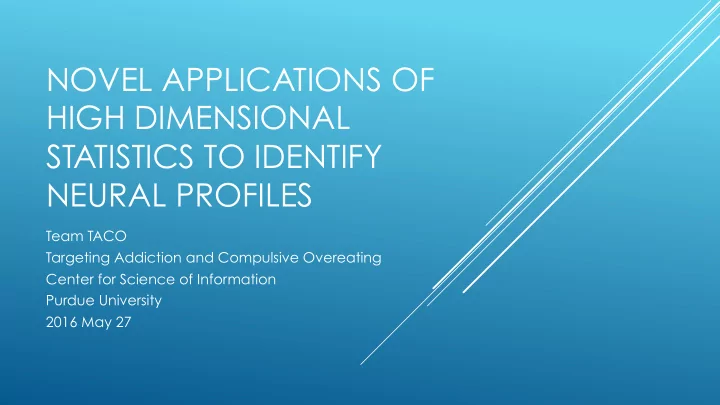

NOVEL APPLICATIONS OF HIGH DIMENSIONAL STATISTICS TO IDENTIFY NEURAL PROFILES Team TACO Targeting Addiction and Compulsive Overeating Center for Science of Information Purdue University 2016 May 27
THE PROBLEM: NEURAL PROFILES OF RESPONSE TO FOOD CUES Obesity affects >30% of the population The brain responds to food cues similarly to drugs of abuse Reward Especially in pathological overeating fMRI measures blood flow, as a correlate of neural activity
THE DATA Baseline After-surgery Hungry Lean/Obese Lean/Obese Conditions Satiated Lean/Obese Lean/Obese Contrasts of Food Cues > Neutral Cues Almost a million measurements per subject per time point
BACKGROUND: NEURAL PROFILE OF SATIETY Obese patients will demonstrate reward response to food cues even after eating Puzziferri et al. 2016, Obesity
T1: baseline T2: 6 months after surgery BACKGROUND T3: 12 months after surgery Obese patients will demonstrate reward response to food cues even after eating T1 T1
HYPOTHESES: DOES NEURAL T1: baseline RESPONSE CHANGE AFTER SURGERY? T2: 6 months after surgery T3: 12 months after surgery Obese patients will demonstrate reward response to food cues even after eating T1 T2 T1
HYPOTHESES REGARDING SATIETY T1: baseline T2: 6 months after surgery T3: 12 months after surgery Obese patients will demonstrate reward response to food cues even after eating T1 T3 T2 T1
METHODS OVERVIEW Dealing with 1 million dimensions: Pick brain regions of interest 1. based on the literature Identify which of these regions have most distinct differences 2. between lean and obese subjects Silhouette method to determine if there is a difference between 3. activity in these brain regions Use these regions as features to classify people based on these 4. brain regions, this would support our hypothesis E.g. decision trees 1.
METHODS STEP 1: REGIONS OF INTEREST & REFINING SELECTION
METHODS STEP 2: FEATURE DIFFERENTIATION Treatment v. Control post meal, baseline − 6 0 cntrl V1 0 trt − 6 2 V2 − 4 20 V3 − 10 15 V4 5 − 5 10 V5 − 5 5 V6 − 15 0 V7 − 20 5 V8 − 15 0 V9 − 10 5 5 V10 − 5 − 5 − 6 0 − 4 2 − 10 20 − 5 5 15 − 5 10 − 15 5 − 20 − 5 − 15 0 15 − 10 0 − 5 5
METHODS STEP 3: DETERMINING SEPARABILITY OF GROUPS Can we distinguish between lean controls and surgery patients based on brain activity in key regions? Method: Silhouette Metric for Purity of Clusters Compared to random permutations Feature 2 Feature 1
METHODS STEP 4: (FUTURE DIRECTIONS) Build a classifier to distinguish if people are obese/not from neural data using the decision tree ...to be continued...
LIMITATIONS Small sample size – use time series to generate more measurements/user Lack of behavior measures to corroboroate
CONCLUSIONS & FUTURE DIRECTIONS Prior FMRI analysis focuses on single regions – we’re testing hypotheses with statistical methods for multiple regions We can extend these to other studies (eg. ) and plan to produce an R package for high-dimensional FMRI data analysis for others to use
THANK YOU Brent Ladd Center for Science of Information National Science Foundation Francesca Filbey, PhD Nancy Puzziferri, MD All of our advisors
METHOD 3 We have a similar dataset from New Mexico, N=18 Train a decision tree on one of these Test this tree on the other Determine if we can predict changes in neural activity
Recommend
More recommend